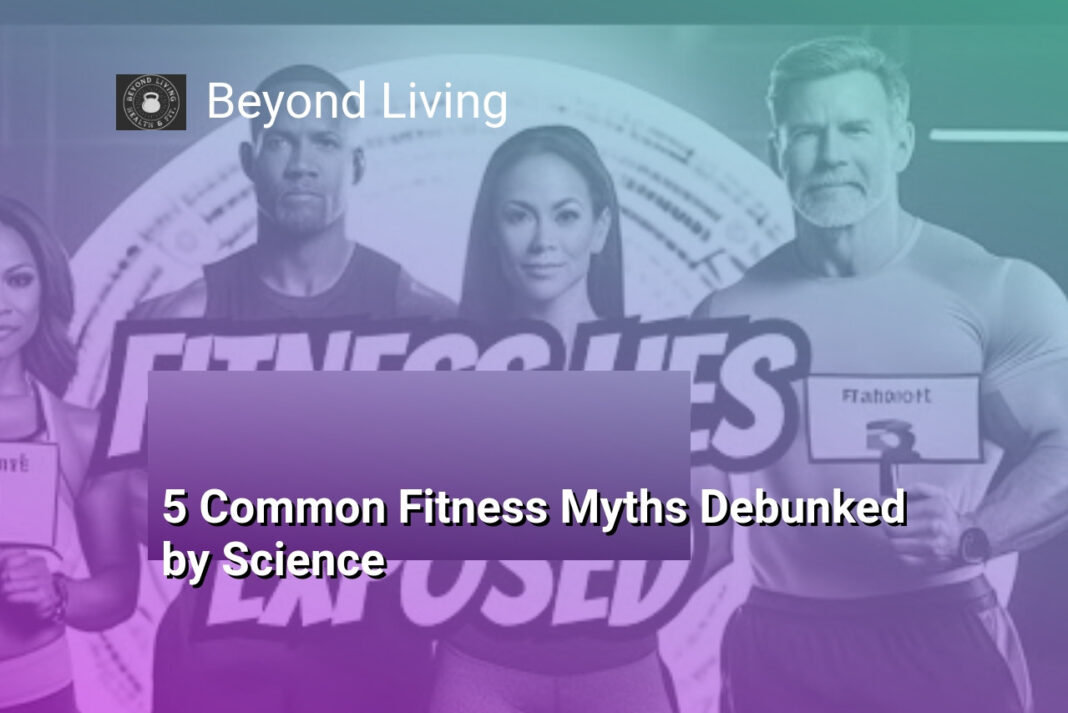The Bottom Line:
Here is a summary of the main points in the requested format:
- Cardio is not the most effective method for long-term weight loss; resistance training builds muscle mass and boosts resting metabolic rate, leading to greater fat loss and preservation of lean body mass.
- Spot reduction of fat is a myth; fat loss occurs systematically throughout the body based on factors like genetics, hormones, and overall energy balance, not through targeted exercises.
- Lifting weights will not make women bulky due to lower testosterone levels; strength training offers benefits such as increased muscle tone, improved bone density, enhanced metabolism, and a more sculpted physique.
- Shorter, high-intensity interval training workouts can be as effective as longer sessions for improving cardiovascular health, metabolic function, and overall fitness in less time.
- Building muscle on a plant-based diet is possible; plant-based protein sources can be as effective as animal sources when consumed in adequate amounts and strategically combined.
Myth 1: Cardio Reigns Supreme for Weight Loss
The Calorie Conundrum: Cardio vs. Resistance Training
While cardio certainly burns calories during the activity, its impact on long-term weight loss may not be as significant as once thought. Scientific research suggests that resistance training, often overlooked in weight loss strategies, can yield remarkable results. Unlike cardio, which primarily burns calories during the workout, resistance training builds muscle mass. Muscles are metabolically active tissues, meaning they burn calories even at rest.
Studies comparing the effects of cardio and resistance training on weight loss have revealed intriguing findings. While cardio may lead to initial weight loss, it often results in concurrent muscle loss, which can hinder metabolic rate in the long run. On the contrary, resistance training not only burns calories during the workout but also promotes muscle growth, thereby boosting resting metabolic rate. In fact, research indicates that incorporating resistance training into your regimen can lead to greater fat loss and preservation of lean body mass compared to cardio alone.
The Misconception of Immediate Calorie Burn
One reason for the persistent belief that cardio reigns supreme for weight loss could be the immediate calorie burn experienced during cardio sessions, which may overshadow the long-term metabolic benefits of resistance training. Additionally, the misconception may stem from the emphasis on cardiovascular health benefits associated with aerobic exercise.
However, when it comes to shedding pounds and keeping them off, the science leans heavily in favor of resistance training. By building lean muscle mass, resistance training enhances your body’s ability to burn calories even when you’re not actively exercising. This increased resting metabolic rate can contribute to sustained weight loss over time.
Striking the Right Balance: Combining Cardio and Resistance Training
While resistance training holds significant advantages for weight loss, it’s important to note that a well-rounded fitness routine should include both cardio and strength training. Cardiovascular exercise offers numerous health benefits, such as improved heart health, increased endurance, and enhanced mood.
The key is to strike a balance between the two forms of exercise. Incorporating resistance training into your weight loss journey can help you build lean muscle, boost your metabolism, and achieve long-term results. Simultaneously, engaging in regular cardio sessions can support overall cardiovascular health and contribute to a calorie deficit.
Ultimately, the most effective approach to weight loss is a comprehensive one that combines a balanced diet, resistance training, and cardiovascular exercise. By debunking the myth that cardio alone is the key to shedding pounds, we can empower individuals to embrace a more holistic and science-backed approach to their fitness goals.
Myth 2: Spot Reducing Fat is Possible
The Myth of Targeted Fat Loss
The concept of spot reduction is a pervasive myth in the fitness world. Many people believe that by performing targeted exercises for specific areas, such as doing crunches to reduce belly fat or tricep dips to eliminate arm flab, they can selectively burn fat in those regions. However, the scientific evidence clearly debunks this notion.
When you engage in physical activity, your body draws energy from its fat stores, known as adipose tissue, from various parts of the body. This process is regulated by a complex interplay of genetics, hormones, and metabolic factors. Spot reduction is physiologically impossible because you cannot control where your body chooses to burn fat from.
The Evidence Against Spot Reduction
Numerous studies have investigated the efficacy of targeted fat loss techniques, particularly in the context of abdominal exercises and belly fat. Consistently, the results have shown minimal to no impact on reducing fat in specific areas. Instead, fat loss occurs systematically throughout the body, influenced by factors such as overall energy balance, diet, and genetics.
One study published in the Journal of Strength and Conditioning Research compared the effects of abdominal exercises versus whole-body resistance training on body composition. The researchers found that while both groups experienced overall fat loss, there was no significant difference in abdominal fat reduction between the two groups. This finding reinforces the notion that spot reduction is a myth.
A Comprehensive Approach to Fat Loss
While targeted exercises can certainly strengthen specific muscles and contribute to overall body composition, they alone cannot dictate where your body burns fat from. To achieve sustainable fat loss results, a comprehensive approach that combines a balanced diet, regular physical activity, and consistency in your fitness routine is essential.
Instead of focusing on spot reduction, shift your attention to creating a calorie deficit through a combination of healthy eating habits and increased overall activity levels. Engage in a variety of exercises that target different muscle groups and incorporate both cardiovascular and resistance training for optimal results.
Remember, the key to successful fat loss lies in patience, persistence, and a holistic approach to health and wellness. By letting go of the myth of spot reduction and embracing evidence-based strategies, you can work towards achieving your fitness goals in a sustainable and effective manner.
Myth 3: Lifting Weights Makes Women Bulky
Strength Training for Women: Empowering, Not Bulking
The fear of becoming bulky has long deterred women from incorporating weightlifting into their fitness routines. However, this misconception is rooted in outdated beliefs and societal norms rather than scientific evidence. Women’s physiology, particularly their lower testosterone levels compared to men, makes them less predisposed to gaining large amounts of muscle mass through weightlifting alone.
Unveiling the Benefits of Resistance Training
Strength training offers a multitude of benefits for women, far beyond the myth of bulking up. Engaging in resistance exercises promotes increased muscle tone, improved bone density, and enhanced metabolism. Building lean muscle through weightlifting contributes to a more defined and sculpted physique, rather than a bulky appearance. Numerous studies have demonstrated the efficacy of weightlifting in women, showcasing improvements in strength, body composition, and overall health.
Challenging Misconceptions and Embracing Empowerment
It’s time to challenge the misconceptions surrounding women and weightlifting. Misconceptions often arise from misconstrued perceptions of female athletes or fitness models who have achieved muscular physiques through dedicated training and nutrition regimens tailored to their specific goals. These individuals serve as examples of what is possible with commitment and hard work, rather than a representation of the inevitable outcome of lifting weights.
Embracing strength training as a woman is an empowering choice. Incorporating resistance exercises into your fitness routine not only enhances physical strength but also fosters a greater sense of confidence and self-assurance. Whether your goal is to improve overall health, boost functional strength, or enhance your physique, weightlifting is a valuable tool in your fitness arsenal.
So, let’s break free from the myths and embrace the transformative power of strength training. Grab those dumbbells, challenge yourself, and unlock your true potential. Remember, being strong is not synonymous with being bulky; it’s a testament to your dedication, resilience, and the incredible capabilities of the female body.
Myth 4: Hour-Long Workouts are Necessary for Results
Shorter Workouts Can Be Just as Effective
Contrary to popular belief, scientific research suggests that shorter, more intense workouts can be just as effective, if not more so, than longer sessions. The key lies in the concept of high-intensity interval training (HIIT), which involves alternating between short bursts of intense exercise and brief periods of rest or low-intensity activity. Studies have shown that HIIT can elicit significant improvements in cardiovascular health, metabolic function, and overall fitness in a fraction of the time compared to traditional steady-state cardio workouts. This is due to the physiological adaptations that occur during high-intensity intervals, such as increased calorie burn, improved oxygen utilization, and enhanced fat oxidation.
The Convenience of Shorter Workouts
Moreover, shorter workouts offer practical advantages for individuals with busy lifestyles. The accessibility and convenience of HIIT make it easier to squeeze in a quick workout during a busy day, eliminating the need for lengthy gym sessions. Whether you’re short on time or simply looking to shake up your routine, incorporating HIIT into your fitness regimen can yield impressive results in less time. So say goodbye to the hour-long treadmill sessions and hello to the power of high-intensity intervals. Your body will thank you for it.
Challenging the Misconception
So why the persistent belief that longer workouts are necessary for results? One reason could be the misconception that more time spent exercising equates to greater calorie expenditure and faster progress. Additionally, traditional fitness norms and workout routines often emphasize endurance and duration, perpetuating the notion that longer is always better. It’s time to challenge these preconceived notions and embrace the efficiency of shorter, more intense workouts.
Myth 5: Building Muscle on a Plant-Based Diet is Impossible
The Power of Plant Protein
Contrary to popular belief, building muscle on a plant-based diet is not only possible but can be highly effective. Plant-based protein sources such as legumes, tofu, tempeh, nuts, seeds, and even grains contain significant amounts of protein necessary for muscle repair and growth. These protein sources, when consumed in adequate amounts and combined strategically throughout the day, can provide the essential building blocks for muscle development.
Debunking the Myth: Studies Support Plant-Based Muscle Building
Numerous studies have debunked the myth that animal-derived protein is superior for muscle building. Research suggests that plant-based protein sources can be just as effective as animal sources in supporting muscle growth and recovery. Plant-based foods are often rich in antioxidants, vitamins, and minerals that support overall health and aid in the muscle-building process. By incorporating a variety of plant-based protein sources and ensuring adequate caloric intake, individuals can successfully build and maintain muscle mass on a plant-based diet.
Reframing the Perception of Plant-Based Nutrition
The misconception that muscle growth is reserved for carnivores has long plagued the perception of plant-based diets. This belief may stem from misinformation, outdated beliefs, and the association of muscle building with animal products in mainstream fitness culture. However, it’s time to reframe our understanding of plant-based nutrition and its role in muscle building. Whether you’re a dedicated vegan athlete or simply looking to incorporate more plant-based meals into your diet, rest assured that you can indeed build muscle on a plant-powered plate. By challenging these misconceptions and embracing the power of plant protein, individuals can unlock their full potential for muscle growth and overall health.





